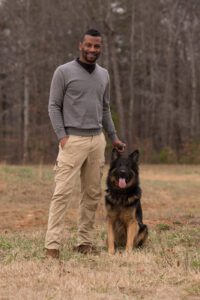Five easy commands to teach your pup.

Do you have a rambunctious new puppy or a dog of any age that could benefit from brushing up on the basics? Learn how to teach the five basic yet game-changing commands for good manners and more order inside and outside the house with these tips from Evan Dunbar, president of Full Contact K9, who works with clients in various neighborhoods including Sandy Springs and Dunwoody.

1. COME
It’s important to teach your dog to come to you when called for safety or any number of reasons. Say “come” and show him a toy or treat, then reward him when he obeys. Over time, subtract the toy or treat.
According Dunbar, many people go about this the wrong way, especially if the dog is doing something wrong such as chewing a shoe. What happens, he says, is the pooch learns he will get in trouble if he goes to you.
“We don’t ever want to do that. We want to take the object and teach the puppy that we are the most fun people in the world to come to, and they’re not going to be punished for coming back to us. That’s how we create a reliable recall over time.”
2. SIT
Training your dog to sit helps him stay calm and polite. Teach the trick with the lure method. Hold a treat above your dog’s nose and slowly move it straight back while saying “sit.” Your dog will likely fall into a sit as he follows your hand. Over time, he will associate the word with the command.
3. DOWN
“Sit and down are really the building blocks of having a compliant dog and a dog that is responsive to their owner,” Dunbar says.
Once he’s mastered “sit,” use the same lure method to teach “down.” Tell your dog to sit. Then hold a treat to his nose, bring it between his front paws and drag it along the ground while saying the command. When the dog lies down as he follows the treat, praise him. Over time, you can lose the treat and use the signal of lowering your hand toward the ground.
4. PLACE
Place is the opposite command of “come.” It instructs your puppy to go away to a certain spot, such as his bed. This can come in handy in circumstances when a guest might be fearful of dogs.
Train “place” by saying the command, offering a treat to get the dog onto its spot and praising. The goal is to teach that going away is as healthy as coming, says Dunbar.
5. STAY
Think of the command “stay” as a pause in time. “It essentially means that there’s an interruption,” says Dunbar. “Like during a football game, the referee will say, ‘Time out, pause.’ That’s essentially how we want the dog to interpret stay. We’ll continue our walk, but right now I’m having a conversation with someone, and I want you to sit here calmly and be patient.”
Have your dog sit or lie down, then say “stay.” Release your dog from the stay by choosing another command, such as “OK” or “free.” Give a reward after you release. Gradually extend the length of time your dog is expected to stay. “You can’t expect a toddler to sit quietly for a long dinner at a nice restaurant. The same is applicable to puppies. We have to gradually build their duration,” Dunbar says.
FULL CONTACT K9
678.235.5959
fullcontactk9.com
@fullcontactk9
STORY: Hailey Hudson
Simply Buckhead is an upscale lifestyle magazine focused on the best and brightest individuals, businesses and events in Buckhead, Brookhaven, Sandy Springs, Dunwoody and Chamblee. With a commitment to journalistic excellence, the magazine serves as the authority on who to know, what to do and where to go in the community, and its surroundings.











